
Handheld mobile devices have become an extension of the human body. It has become our constant companion which we carry with us everywhere and all the time. The business world is exploring new ways and means to leverage this profound impact of mobility revolution in human life. Capturing analytics from mobility and deriving useful insights from it is one of the major trends that almost all lines of businesses follow now. Business requires going close to the individual user’s behavioral aspects which enable them to optimize their LOB (Line of Business) in a more customer oriented manner. Data is information and it directly helps to refine and optimize the LOB. Analytics represents the analysis of those data points and refining/optimization of the LOB depending upon the nature of the business and customer expectations. Let us have a look on why capturing
Collecting data point for improving the business model is not a new practice. Manual data collection was present in almost all fields. However, it may slightly differ from the current models of data collection and analysis for business insights generation. For example, the data collection from a retail shop will be about how much of quantity of an item is sold from different variety of products. It collects data about which products are slow moving in nature. It provides the statistics of products sold, which helps the retailer to analyze where he needs to concentrate more in the business to reap profit. The correction steps will be based on the analysis of the collected data points. In short, collecting data is an age old practice to understand the product’s future connecting to the LOB.
Software Application is no different than any other product in the above example. Since the application is on mobile it means that business is focused on individual customer preferences. Previously, when the applications were only on the desktops and were not able to achieve single user point of views. It was always meant for a group of people (multi user login) and that too at a certain point of access time because of its stationery nature. In contrary, mobile is a device which a user carries throughout the day. Therefore, the gadget to human attachment is strong with single mobile applications usability to a single user. The power to reach an individual user and the importance of collecting data points on behavioral aspects drives greatly to the success of an application.
Retention of the user of an application is the primary objective.
Broadly, the data collection falls into:
1. Operational – all kind of data operational data, right from device to application performance
2. Behavioral – All kind of actions that the user performs with in the application
But if we deep dive into the classification of nature of the data it could be bucked into the following category:
1. Operational – Application performance to device dependency
2. Identity – Device and user’s identity and attributes (Carrier details, demography etc.)
3. Situational – Network speed, location/area of access of the application
4. Behavioral – User preferences, actions, content selection, social sharing
The above data is basically from two major focus areas (aspects):
1. Application pulse – how the application is performing? In order to support many devices with many form factors, it is very important to understand about the health of the application at the runtime. If and only if the application health is good, retention of the user is possible, which makes it a very significant area of assessment.
2. Customer context –To know the inclination of the user base, it is vital to understand the foot print of customer preferences and non-preferences. This will help in retaining the user, extend and optimize the LOB and hence the market share.
Let’s now bring some data, to understand why the above theory is so important to consider?
As a businessman, I would always look how I can multiply my end customer. That’s where my business appreciation takes place and as a result ROI increases. Following are the qualifiers for the data points to be considered in this context to understand which mobile platform in geo, which industry vertical is aligned to my LOB:
1. Mass usage
2. Intensity of usage
3. User preference vs platform
4. Industry vertical adoption vs Mobile Platform
5. Demographic preference on mobile platform adoption
What is the global market share of mobile platform?

What is the trend of time spent by the user on a device?
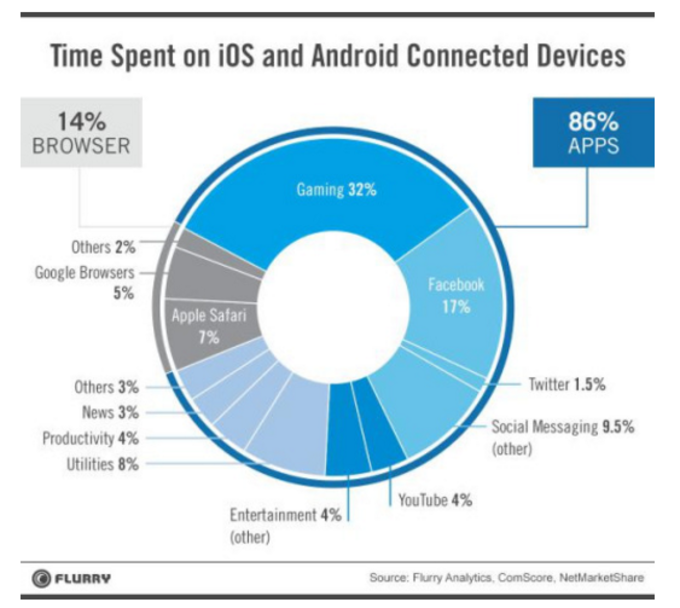
Source: Flurry Insight, April 2014
What is the absorption preference on vertical industries/platform?
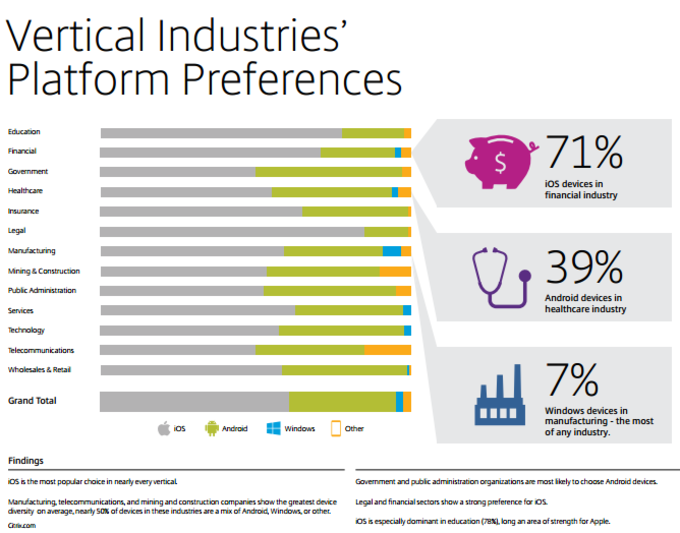
Source: Citrix 2015 Mobile Analytics Report
Demographic wise what is the absorption rate on the selection of device platform?
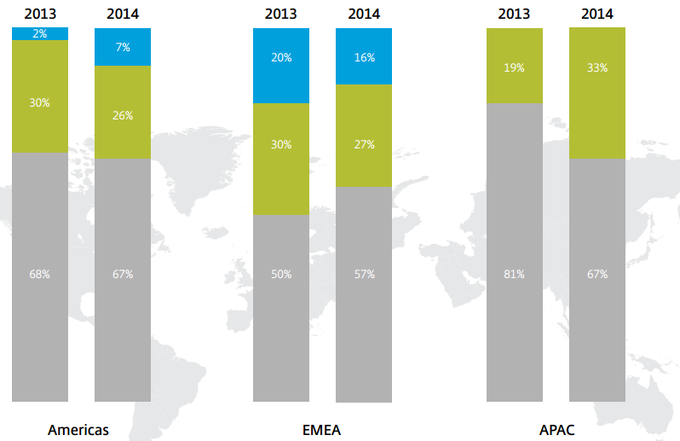
Source: Citrix 2015 Mobile Analytics Report
We can receive the above data points only through the data collection and we need to run analytics on top of it to identify the device level, platform level and domain level platform absorption. Sometimes demographic wise, the platform gets selected and sometimes industry vertical rules over the selection of a mobile device platform.
Let’s now look into the data points on how the trends in the industry are realizing the importance of analytics on mobility against their business objectives?
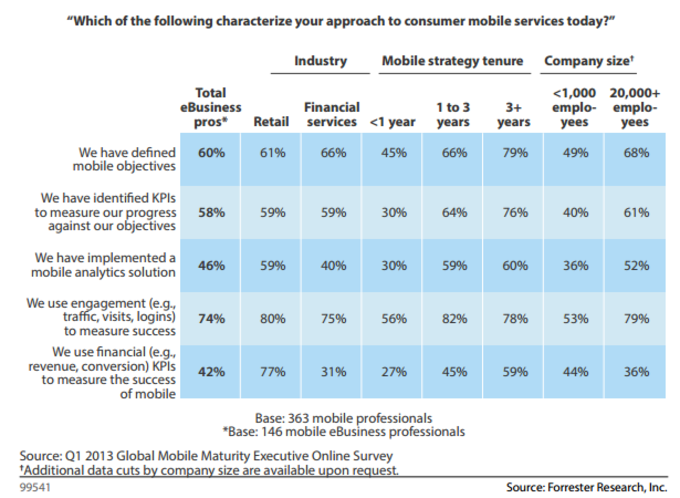
Source: Forrester Research, Inc
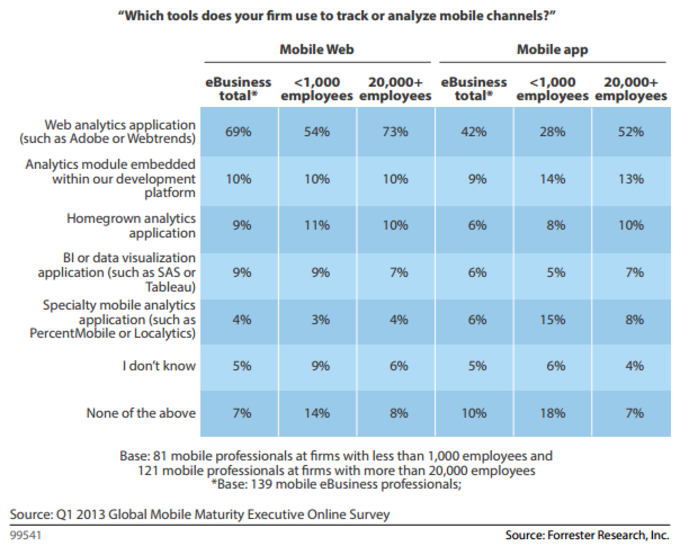
Source: Forrester Research, Inc
Above figure explains how mobile analytics absorption is taking place keeping the business objective in mind. There are several mobile analytics vendor available in the market to support the same or you can build customized analytics for your application.
We can consider embedding Mobile analytics at the application level as a primary factor for the success of an application. It helps in gathering information which in turn help to provide larger market share and correction of LOB on mobility. Retention of the user base to the application seems to be more defined. The captured data on the industry based absorption of devices as well as platform selection and demography helps to concentrate on the entry point to the application market.
The intelligent combination of Mobility and Analytics has become an integral part of the digital transformation strategies of the new generation IT organizations. In this age of Big Data and Mobility revolution, the data collected from your personal handheld device holds the power to redefine your business and its market share. Making intelligent use of it to derive valuable business insights helps in empowering organizations and industries in treading into the new heights of growth.
Are you ready to explore more on this winning combination?
(The article has been authored by Subir Roy, Solution Architect and Practice Head, Mobility at Happiest Minds Technologies)
Image credit: Indiatimes